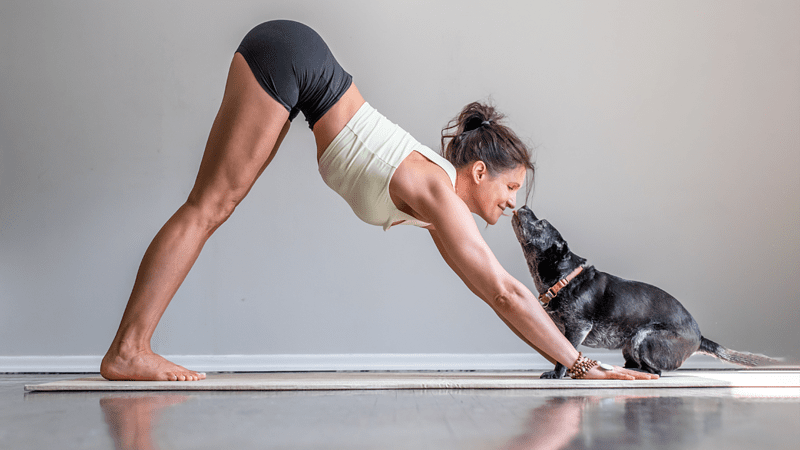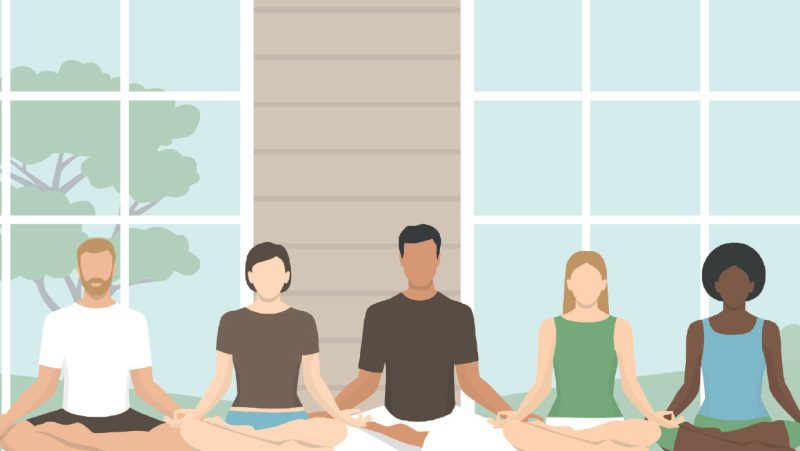
Are you Yoga Strong?
How adding weights to yoga improves bone health
Reading time: 4 minutes
It really shocked me to learn that half of women aged over 50, and 1 in 5 men, will break a bone due to osteoporosis! Often it happens right out of the blue, after a small trip or fall. We probably all know someone middle aged that has suddenly tripped and broken or fractured something unexpectedly. In many cases, it was the first time the person had any idea that they had a problem. Osteoporosis and its precursor, osteopenia, are known a ‘silent diseases’ for this reason. And they persist in part because 80% of us aren’t doing enough of the right kinds of exercise to keep their bones strong.
We know that bone strength (bone density) naturally reduces with age and it’s especially important for women going through the menopause to be working on maintaining it. Walking, running and the obvious weightlifting tend to be the go-to exercises for bone health management, but scientific research has shown that yoga is also very effective. Good news for dedicated yogis. Apart from walking, yoga is also more accessible, which is very important. Running is hard on the body and many people either cannot or shouldn’t be running regularly. After suffering two ruptured Achilles tendons and multiple foot surgeries, I am one of them. Many other people - especially yogis - have a real dislike of gyms. The prospect of lifting weights just doesn’t appeal to them.
Yoga is also a form of strength training as we yogis all know - using body weight - which makes it an ideal entry point for anyone. Strange for non-yogis to comprehend considering that the stereotype for most people is to ‘do yoga’ to become more flexible, but long-term research has shown its efficacy for boosting bone density.
Between 2005 and 2015, Dr. Loren Fishman conducted one of the most comprehensive studies on yoga and bone health ever undertaken. His research was based on 227 people who already had osteoporosis or osteopenia, and they were given a 15 minute. daily practice of 12 specific yoga poses, each to be held for up to one minute. The practice included the obvious standing postures - Warrior II, Triangle, Tree, plus Locust pose, Bridge for spine strengthening, twists and some supine stretches.
Each pose was selected because it targets a part of the body that is vulnerable to stress fractures. For instance, the weight-bearing poses place beneficial stress on the legs, hips, and spine. They require balance and muscular engagement, stimulating bone growth in the areas most prone to fractures from falls. The findings were statistically significant and showed that bone density was either maintained or improved in the spine, hips, and femur among the participants who practiced moderately to fully (at least every other day). In addition, a further study revealed better internal bone (fascial) support – which is important for resisting fractures.
Interestingly, the 12 minute research practice included Savasana as one of the 12 poses. We all tell our students that it’s the most important posture of all to integrate the benefits of a yoga practice and the findings of the study further reinforce this. Lying down allows our nervous systems to re-balance and reduces the stress hormones which are known to contribute to bone density loss. It’s another very important factor behind the efficacy of yoga and the role of rest and relaxation for strengthening bones.
You might wonder how holding these yoga poses can strengthen bones. The answer lies in understanding how bones respond to stress. When you hold a yoga pose, you’re creating isometric contractions – the muscles engage and “hug” the bone in a static position. This causes mechanical loading on the bones and stimulates the production of specialised cells called osteocytes, which trigger a biochemical process that increases bone formation while decreasing bone resorption. The production of osteocytes is what maintains our bone density and strength. As we age, our bodies produce fewer osteocytes, which is why our bones can become brittle and weaken.
So a regular yoga practice – 3 times a week ideally – will at the very least maintain a healthy bone density in an ageing population. The key is holding the right postures for sufficient time to generate the right levels of stress on the body. In Dr. Fishman’s study, each pose was held for approximately one minute, creating enough mechanical stress to stimulate bone-building activity without risk of injury. This is important, not a single person taking part in the research experienced any ill effects from taking part – whereas many people injure themselves running or in the gym.
When extra resistance with weights is incorporated into a yoga practice, these bone strengthening effects are further enhanced. Just a modest external load of 1–3 kilograms of extra weight per limb will achieve light-to-moderate muscular strain and can begin to stimulate osteocyte production. Doing yoga with weights promotes measurable improvements in bone density over time – without overloading joints. This is what inspired me to develop Yoga Strong as a style of practice. It’s a strong flow style practice with added weights for resistance and the effects can be seen much more quickly than with body weight alone.
How to Get Started – Practicing Yoga for Bone Strength
- To use yoga as a bone strength training exercise, the key is consistency. Aim to be practicing at least 3 times weekly for 30 minutes at a time.
- The research studies have shown that improvements in bone density from yoga take time to show substantial benefits. You need to be maintaining the practice for 12 months at least.
12 Top Postures for Strength – according to Dr Fishman’s study, but many others can be added for variety.
Vrikshasana
Trikonasana
Virabhadrasana II
Parsvakonasana
Parivrtta Trikonasana
Salabhasana
Setu Bandhasana
Supta Padangusthasana I & II
Marichyasana II
Matsyendrasana
Savasana
- Begin with 1kg weights. I use ankle and wrist weights in my classes to begin with as it allows more freedom of movement and add extra hand weights for certain postures. Gradually increase the resistance to 2-4kg per limb once posture integrity and alignment are stable.
- If you’re inspired to try yoga for bone strengthening and want to see accelerated results, join me at one of my regular Yoga Strong classes or book a beginner’s course. You can join me in my Kingston studio or live online. Details of when classes and courses are running can be found on my website: https://behappyyoga.fit/yogastrong/
To learn more about whether you are at risk of getting osteoporosis for yourself, take the 3 minute online study offered by the Royal Osteoporosis Society – and ask your GP for a bone density scan if you have any of risk factors. It will also be important to review your diet and make sure you are getting enough calcium and vitamin D – especially in the winter months. Take the study here: https://theros.org.uk/risk-checker/?campaign=77a866ee-c708-ed11-82e5-0022481b5a28





